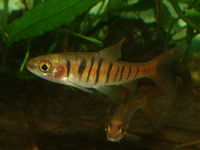Blue-Barred Barb (Barbus fasciolatus)
From The Aquarium Wiki
Blue-Barred Barb
Barbus fasciolatus
57 Litres (15 US G.)
5.1-6.1cm (2-2.4 ")
Freshwater
6.0 - 6.5
22 -26 °C (71.6-78.8°F)
5-12 °d
1:2 M:F
3-5 years
Family
Cyprinidae
This animal is available captive bred
Contents
Additional names
- Blue-Barred Barb, African Banded Barb, Fire Barb, Angolan Barb
Additional scientific names
- Barbus barilioides, Barbodes fasciolatus, Puntius fasciolatus
Origin
- Found throughout the Zambezi river system, the Cunene and Kafue Rivers, Luapula-Mweru system. Also known from the Okavango and Zambian Congo systems, and Lake Kariba [1].
Sexing
- Males will have more vibrant colouration when displaying to females.
Tank compatibility
- A reasonably peaceful fish, but do not keep with delicate or shy tank mates as these fish can become boisterous during spawning. Do not keep with long-finned or slow-moving fish as they run the risk of being nipped. Do not keep with larger predatory fish.
Diet
- Will accept most foods, but prefers live/frozen foods such as bloodworm, which is said to enhance their colouration.
Feeding regime
- Feed once or twice a day.
Environment specifics
- Appreciates a spacious aquarium with equal open swimming space and hiding places. Does best in soft acidic water the addition of oak leaves or blackwater extract which introduces tannins, it is said this may further enhance their natural colouration.
Behaviour
- A generally peaceful loosely shoaling fish, males will bicker between themselves when it comes to displaying to females.
Identification
- Resembles a more elongate Tiger Barb with thinner dark bands, but the same orange base colour. The bars will become iridescent blue-black and the orange rich and vibrant in the males when they display to females.
Pictures
References
External links
- Fishbase (Mirrors:
 )
)
